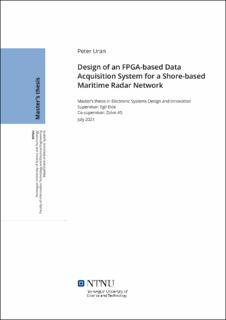| dc.contributor.advisor | Eide, Egil | |
| dc.contributor.advisor | Zolve AS | |
| dc.contributor.author | Uran, Peter | |
| dc.date.accessioned | 2021-12-07T18:19:25Z | |
| dc.date.available | 2021-12-07T18:19:25Z | |
| dc.date.issued | 2021 | |
| dc.identifier | no.ntnu:inspera:77039769:21723089 | |
| dc.identifier.uri | https://hdl.handle.net/11250/2833232 | |
| dc.description.abstract | Et landbasert nettverk av maritime radarer skal utvikles av NTNU og Sintef som en del av
Ocean Lab Node 2-infrastrukturen. Hensikten med nettverket er å spore både autonome og
tradisjonelle fartøy i Trondheimsfjorden for å bidra til en delt situasjonsbevissthet. Denne rapporten
presenterer en systemarkitektur for eksterne radarsteder, basert på sampling av radardata på stedet
og opplasting via det nye 5G-nettverket i Trondheim for å minimere infrastrukturkostnadene. Et
datainnsamlingssystem er utviklet basert på Analog Devices AD-FMCDAQ2 ADC og et iWave Intel
Arria10 SoC / FPGA FMC+ utviklingskort. En Simrad Halo 20+ pulskompresjonsradar er tiltenkt
for systemet som del av prosjektet. Radarbølgeformene måles og viser seg å overføre både pulser og
chirps med varierende senterfrekvenser og båndbredde. Båndbredden for en chirp måles til maksimalt
30 MHz, som forventes å resultere i 1.0 Gbit/s opplinkingsdata. Datainnsamlingssystemet er vist å
utføre IQ-demodulering, klokkedomenekryssing og pulskompresjon i simulering. Pulskompresjon
oppnås ved dynamisk å lage et matchet filter fra den overførte chirp-en for å ta hensyn til den
alternerende senterfrekvensen og båndbredden til chirpen. Den nødvendige filterlengden ble
ikke oppnådd på grunn av overutnyttelse av FPGA-multiplikatorene, som flere løsninger blir
diskutert til. Et driverproblem forhindret testing av dechirping i maskinvare. Prosjektet bruker
også continuous integration for å simulere FPGA-design med VUnit-testrammeverket og GHDL-
simulatoren med åpen kildekode. Det er også demonstrert hvordan VUnit kan brukes til å verifisere
signalbehandlingskjeden ved å generere og validere simuleringsdata i Python, fremfor bruk av ren
VHDL. | |
| dc.description.abstract | A shore-based network of maritime radars is to be developed by NTNU and Sintef as part of the
Ocean Lab Node 2 infrastructure. The purpose of the network is to track both autonomous and
traditional vessels in the Trondheim fjord and contribute to a shared situational awareness. This
report presents a system architecture for the remote radar sites, based on sampling the radar
data on-site and transmitting the data via the emerging 5G network in Trondheim to minimize
the cost of infrastructure. A data acquisition system is developed based on the Analog Devices
AD-FMCDAQ2 ADC and an iWave Intel Arria10 SoC/FPGA FMC+ Development Kit. A Simrad
Halo 20+ pulse compression radar is currently considered for the system. The radar waveforms
are measured and revealed to transmit both pulses and chirps with varying center frequencies and
bandwidths. The sweep bandwidth is measured to a maximum of 30 MHz, which is expected to
result in 1.0 Gbit/s of uplink data. The data acquisition system is shown to successfully perform
IQ demodulation, clock domain crossing and pulse compression in simulation. Pulse compression is
achieved by dynamically creating a matched filter from the transmitted chirp to account for the
alternating center frequency and bandwidth of the chirp. The required filter length was not achieved
due to over-utilization of the FPGA multipliers, to which multiple solutions are discussed. A driver
issue prevented the testing of the dechirping in hardware. The project also makes successful use of
a continuous integration workflow for simulating the FPGA design with the VUnit test framework
and the open source GHDL simulator. It is also demonstrated how VUnit can be used to verify the
signal processing chain by generating and validating simulation data in Python, rather than pure
VHDL. | |
| dc.language | eng | |
| dc.publisher | NTNU | |
| dc.title | Design of an FPGA-based Data Acquisition System for a Shore-based Maritime Radar Network | |
| dc.type | Master thesis | |
